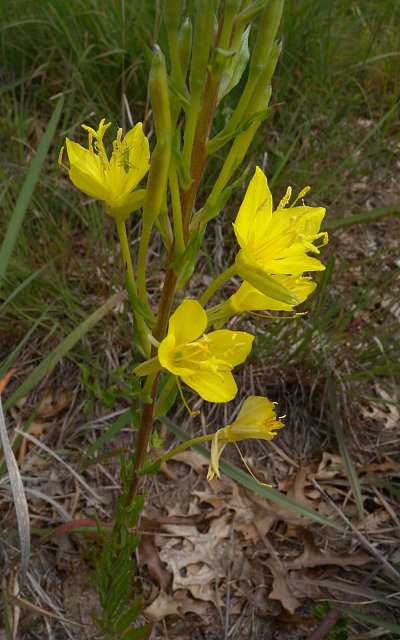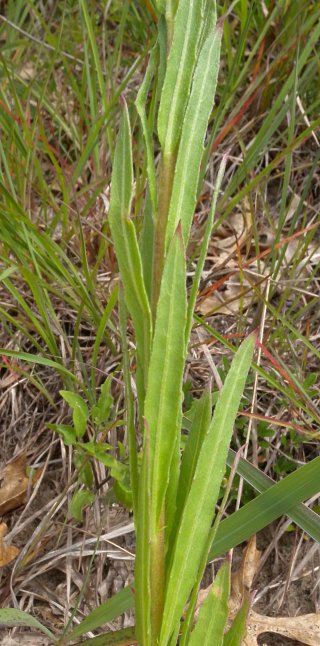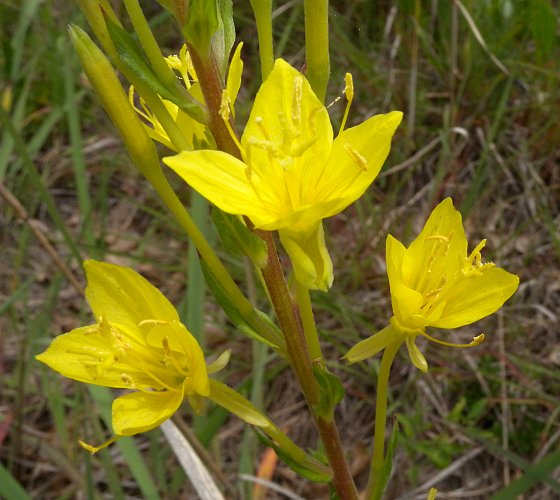Description: This annual or biennial wildflower initially forms a low rosette of basal leaves spanning 3-6" across. It later bolts, developing little-branched flowering stalks about 1-2' tall (less often, up to 3' tall). The light green stems are densely covered with appressed white hairs. The alternate leaves are up to 2½" long and ½" across; they are ascending to widely spreading. Most leaves are sessile, although some lower leaves have short petioles. The leaf blades are linear-lanceolate, lanceolate, or oblong in shape; their margins are smooth or remotely dentate with barely perceptible teeth. Upper leaf surfaces are medium green and sparsely covered with appressed white hairs, while lower leaf surfaces are pale green and more densely covered with appressed white hairs.

The central stem
terminates in a leafy spike of flowers about 3-9" long; secondary
spikes of flowers may be produced from lower lateral stems. Like the
central stem, the flowering stalk is light green and densely covered
with appressed white hairs. Flowers and developing seed capsules are
densely arranged around the stalk. Individual flowers span ½–1¼" across
when they are fully open. Each flower has 4 yellow pointed petals, 4
linear sepals, a narrowly cylindrical calyx tube, 8 stamens, a central
style (actually 4 united styles) with a cross-shaped stigma, and a
sessile ovary. Individual petals and sepals are 1/4–5/8" (6-15 mm.)
long; they are
both deciduous. Pale thin lines radiate across the petals from the
center of the flower – these function as nectar guides. The blooming
period occurs from mid-summer to early fall and lasts about 1½–3
months. The flowers bloom during the night and also on cloudy days.
After individual flowers bloom, their ovaries begin to swell in size
and become seed capsules. Individual seed capsules are up to ¾" long
with a slightly curved and cylindrical shape; they are 4-celled and
bluntly 4-lobed. The surface of each capsule is either glabrous or
sparsely covered with
appressed white hairs. Two rows of small seeds are contained in each
cell of the capsule. Individual seeds are obovoid in shape. The root
system consists of a taproot. This wildflower reproduces by reseeding
itself.
Cultivation:
The preference is full sun, dry-mesic to dry conditions, and sandy soil.
Range & Habitat:
The native Cleland's Evening Primrose is occasional in sandy areas of
northern and
west-central Illinois, while elsewhere in the state it is rare or
absent (see Distribution
Map). The distribution map doesn't distinguish between
Cleland's Evening Primrose and the more western Sand Evening Primrose
(Oenothera rhombipetala); most observations are the
former species.
Habitats include upland sand prairies, sandy hill prairies, sand dunes,
upland sandy savannas, abandoned sandy fields, areas along sandy paths,
and areas along railroads. Slightly disturbed areas are preferred;
occasional wildfires are beneficial in reducing the encroachment of
woody vegetation.

Faunal
Associations:
The nocturnal flowers are pollinated by Sphinx moths; they are also
visited by the Ruby-Throated Hummingbird and various long-tongued bees,
including the oligolectic bees Lasioglossum oenotherae
and Anthedonia compta. These visitors seek mostly
nectar from the flowers, although some bees also collect pollen for
their larvae. Various insects feed on the leaves, seed capsules, or
plant juices of Cleland's Evening Primrose and similar species. These
insect feeders include the caterpillars of several moths: Hyles
lineata (White-Lined Sphinx), Proserpinus juanita
(Green-Banded Day Sphinx), Schinia florida
(Primrose Moth), Eudryas unio (Pearly Wood Nymph), Phtheochroa
oenotherana (Tortricid Moth sp.), and two Mompha spp.
(Momphid Moths). Other insect feeders include several flea beetles
(Altica spp.), weevils (Tyloderma spp., Chalcoderma collaris,
Acanthoscelidius acephalus), and aphids (Anoecia spp., Aphis
oestlundi). White-Tailed Deer chomp off the flowering stalks of this
wildflower (causing it to branch), while the Common Goldfinch eats the
seeds to a minor extent. The foliage is also edible to cattle and other
hoofed mammalian herbivores.
Photographic Location:
A sandy hill prairie at Hooper Branch Savanna Nature Preserve in
Iroquois County, Illinois.

Comments: On cloudy days, this can be a very showy wildflower. The petals of its flowers are unusual because they are bluntly pointed, rather than well-rounded. Cleland's Evening Primrose is very similar to the more western Oenothera rhombipetala (Sand Evening Primrose). Until recently, these two wildflowers were regarded as the same species. Sand Evening Primrose is more robust and its flowers are larger in size (1¼–2" across). However, some field specimens with mixed characteristics may be difficult to classify as one species or the other. Another common name for either of these two species is Four-Point Evening Primrose.